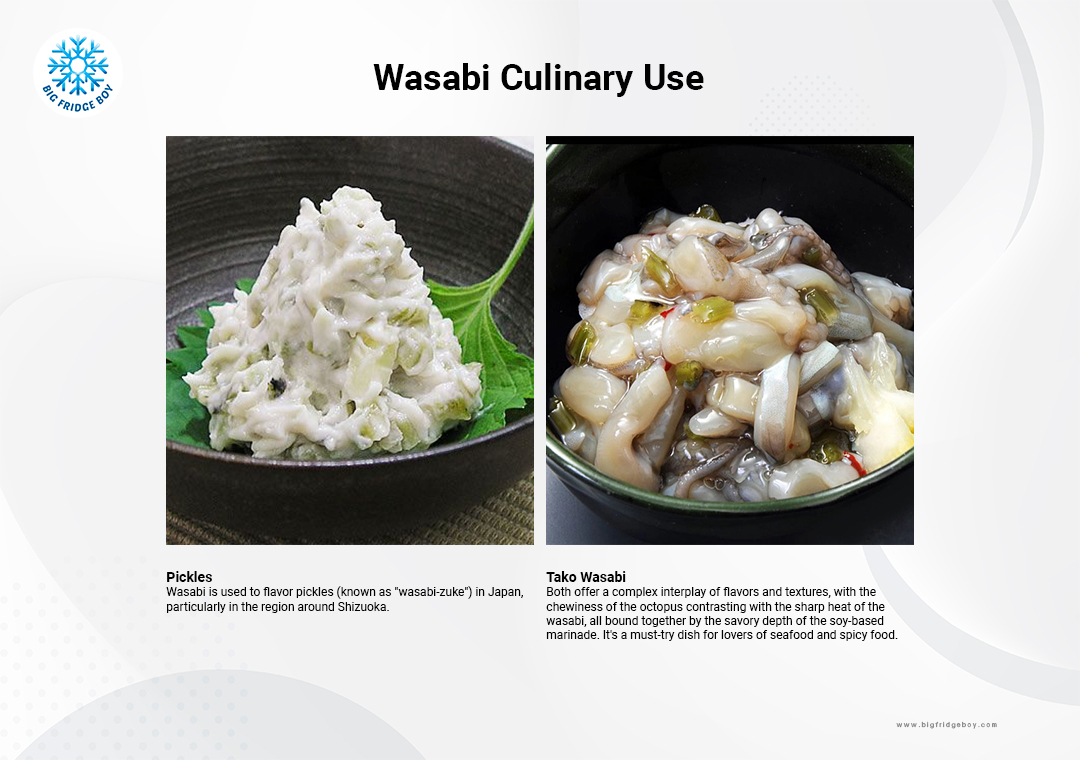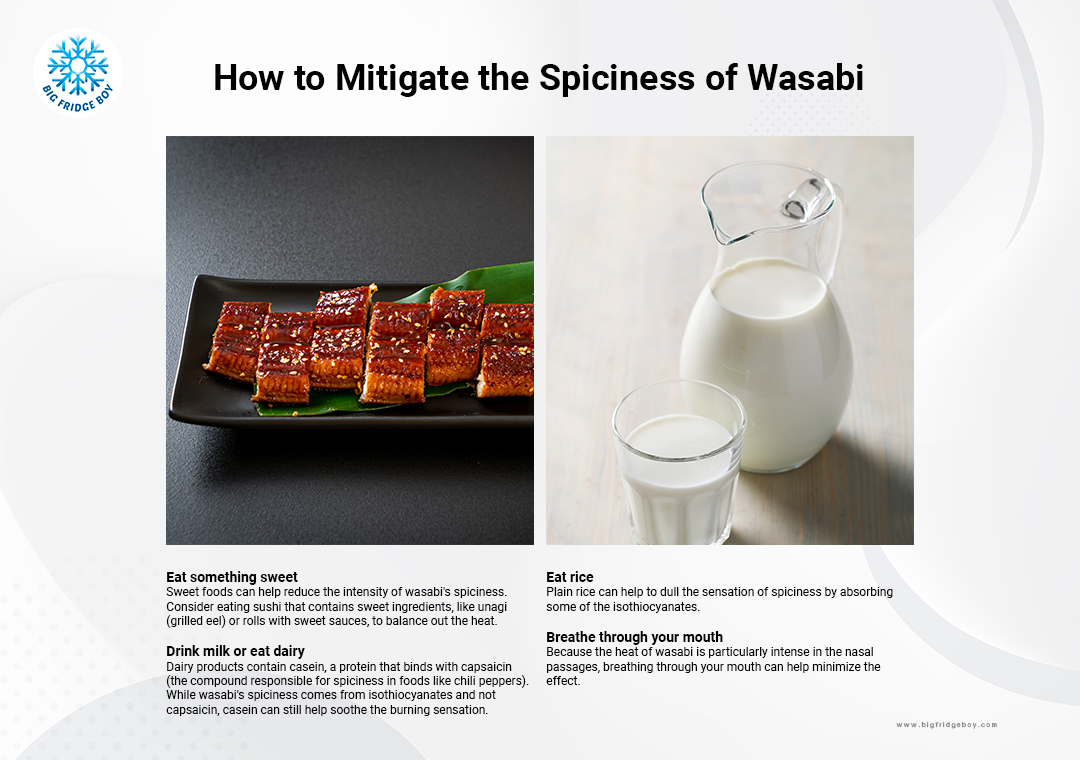All You Need to Know About “Wasabi”
Last updated: 8 Jun 2023 | 2186 Views |

Wasabi (わさび), also known as "Japanese horseradish," is a plant native to Japan that's best known for its root, which is used as a condiment in Japanese cuisine. Though it's a cornerstone of many meals, particularly sushi, there's a lot more to this fiery green paste than meets the eye. Here is all you need to know about wasabi.
Wasabi, scientifically known as "Eutrema japonicum," is a member of the Brassicaceae family, which includes mustard, horseradish, and cabbage. It has been a part of the Japanese diet for over a thousand years and has played a significant role in Japanese culture. In ancient times, wasabi was valued for its medicinal properties and used as a herbal remedy for various conditions.

Cultivation and Harvesting
Wasabi is notoriously difficult to grow. It thrives in shaded, cool, and humid conditions, typically found naturally along Japanese mountain stream beds. The plants take 1.5 to 2 years to mature. During this time, they require precise conditions: consistent temperatures between 8-20 degrees Celsius, 80% to 90% humidity, and protection from direct sunlight, wind, and pests.
When the wasabi plants have matured, the rhizome (the stem that grows horizontally along or under the ground) is harvested. This rhizome is the part that we commonly refer to as "wasabi."
Production and Use
After harvesting, the wasabi rhizome is cleaned and grated to make the green paste typically served with sushi or sashimi. A traditional Japanese grater, made from sharkskin, is often used to achieve the ideal texture.
Wasabi has a unique heat that quickly dissipates, leaving a sweet aftertaste. This makes it distinct from other types of spicy foods that have lingering heat. It's most commonly used as a complement to sushi or sashimi, but it can also be used in soba noodles, rice dishes, and various other recipes.

While wasabi is most commonly associated with sushi and sashimi, its unique flavor and heat have led to its use in a wide range of other culinary applications, both within and beyond traditional Japanese cuisine.
- Noodles
Wasabi is often mixed into noodle dishes, particularly soba. A common preparation is wasabi soba, where the paste is mixed directly into the dipping sauce. - Pickles
Wasabi is used to flavor pickles (known as "wasabi-zuke") in Japan, particularly in the region around Shizuoka. - Tako Wasabi
Both offer a complex interplay of flavors and textures, with the chewiness of the octopus contrasting with the sharp heat of the wasabi, all bound together by the savory depth of the soy-based marinade. It's a must-try dish for lovers of seafood and spicy food. - Steak and Seafood
Wasabi can be incorporated into a sauce or marinade for steak or seafood. It pairs particularly well with fatty meats and fish. - Snacks
Wasabi peas are a popular snack where dried peas are coated in a mixture of wasabi and starch. The wasabi lends a spicy kick to these crunchy treats. Wasabi-flavored chips or popcorn are also popular snacks. - Salad Dressing
Wasabi can be mixed into a vinaigrette to create a punchy dressing for salads. - Desserts
While less common, some innovative chefs and food manufacturers have even started using wasabi in desserts like ice cream and chocolate, where its heat can provide a surprising contrast to the sweetness.
Health Benefits
Wasabi contains several compounds that are beneficial to health. These include isothiocyanates, which have antimicrobial properties, can potentially help to reduce inflammation, and may even have anticancer effects. Additionally, wasabi has compounds that can help digestion and reduce the risk of food poisoning, which is one reason why it's traditionally served with raw fish.
- Antimicrobial Properties
Isothiocyanates, which give wasabi its characteristic heat, have antimicrobial properties. This means they can kill or slow the growth of microorganisms like bacteria and fungi. This property can be particularly beneficial when consuming raw foods that may carry harmful bacteria, such as raw fish in sushi and sashimi. - Anti-Inflammatory Effects
Inflammation is a response by your body's immune system to injury or illness. While it's an essential part of healing, chronic inflammation can lead to various health problems. The isothiocyanates in wasabi have been shown to possess anti-inflammatory properties, which means they can help reduce inflammation in the body. - Potential Anticancer Properties
Some studies suggest that the isothiocyanates in wasabi may have anticancer properties. These compounds may inhibit the growth of certain types of cancer cells. However, more research is needed to confirm these effects and determine how they might be used in cancer prevention or treatment. - Digestive Health
Wasabi contains dietary fiber, which aids in maintaining a healthy digestive system. It helps to add bulk to the stool, preventing constipation, and promoting regular bowel movements. - Cardiovascular Health
The isothiocyanates in wasabi may help reduce the risk of heart disease. They can inhibit platelet aggregation, which is the clumping together of platelets in the blood. Platelet aggregation can lead to blood clot formation, which can increase the risk of heart attacks and strokes. By inhibiting this process, wasabi could potentially help maintain cardiovascular health. - Bone Health
Wasabi is a good source of calcium, which is essential for maintaining healthy bones and teeth. Regular intake of calcium can help prevent osteoporosis, a condition that weakens bones and makes them fragile. - Respiratory Health
Wasabi's strong vapors can stimulate the sinuses and help clear up congestion. This can be beneficial for individuals suffering from allergies or colds.
It's important to note that while wasabi has these potential health benefits, it is usually consumed in small amounts, and therefore, its health impact should be seen as a part of a balanced, nutritious diet.
The Science Behind the Spiciness
The spiciness of wasabi comes from chemical compounds it contains known as isothiocyanates. When you eat wasabi (or when it's grated and exposed to air), an enzymatic process breaks down a compound in the plant called glucosinolates into these isothiocyanates.
Isothiocyanates are volatile, meaning they readily turn into a gas. When you eat wasabi, these gaseous molecules travel up your nasal passage and trigger the TRPA1 receptors in your nose and sinuses. These receptors are pain receptors for irritants, which is why wasabi's spiciness is felt more in the nose and sinuses rather than on the tongue, unlike the heat from chili peppers which activate a different receptor (TRPV1) that's more common in the mouth and skin.
Importantly, the reaction is temporary and usually harmless, though it can be uncomfortable if you're not used to it. The intensity of wasabi's heat diminishes quickly after its initial burst because isothiocyanates are volatile and evaporate quickly. This is why the sharp, intense sensation of eating wasabi subsides just as rapidly as it arrives.

How to Mitigate the Spiciness of Wasabi
- Eat something sweet
Sweet foods can help reduce the intensity of wasabi's spiciness. Consider eating sushi that contains sweet ingredients, like unagi (grilled eel) or rolls with sweet sauces, to balance out the heat. - Drink milk or eat dairy
Dairy products contain casein, a protein that binds with capsaicin (the compound responsible for spiciness in foods like chili peppers). While wasabi's spiciness comes from isothiocyanates and not capsaicin, casein can still help soothe the burning sensation. - Eat rice
Plain rice can help to dull the sensation of spiciness by absorbing some of the isothiocyanates. - Breathe through your mouth
Because the heat of wasabi is particularly intense in the nasal passages, breathing through your mouth can help minimize the effect.
In conclusion, wasabi is a remarkable ingredient with a rich history and unique characteristics. Its cultivation requires precision and patience, mirroring its importance and the care taken in Japanese culinary traditions. Its unique spiciness, derived from isothiocyanates, offers not only a distinctive sensory experience but also several health benefits, including antimicrobial and anti-inflammatory effects. Though its spiciness can be daunting to some, it's temporary and can be mitigated through various means.







